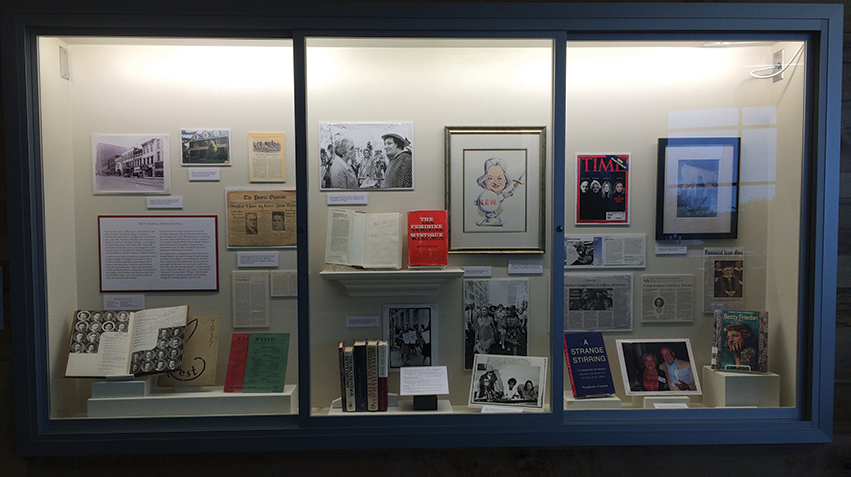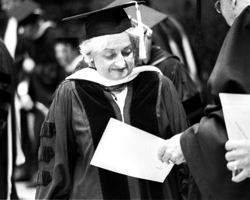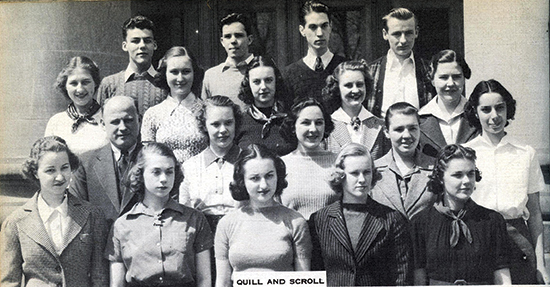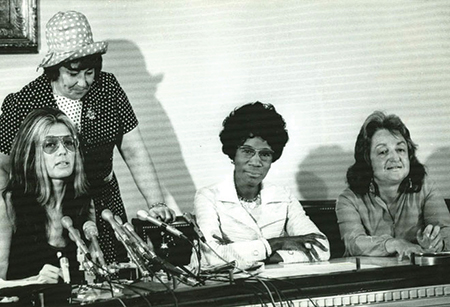As the nation changed, Peoria was always an influence on the work of Betty Friedan.
Historians say Betty Friedan is among the most influential women ever to have lived and her classic, The Feminine Mystique, among the most important books ever written. So when the mother of feminism credits her hometown for much of what she became, I take some pride. It’s among the reasons I’ve worked the last few years to spread Betty Friedan’s story in her hometown.
Not that Bettye Goldstein’s time in Peoria was always happy. It wasn’t. Here was where she learned how bitterly discrimination hurts. Here was where her father, Harry Goldstein, forced her mother, Miriam Horwitz, to quit the newspaper job she loved and become a housewife. Her mother’s resulting unhappiness prompted the child to pray, “When I grow up, I want a work to do.” But here she also made friends for life, returning from time to time when she wanted to try out her ideas on those she considered to be sensible “real women”—as opposed to her “radical Eastern chic” counterparts.
When I interviewed Betty Friedan (she changed the spelling of her first name early in her career) in 1999, I asked what she took from Peoria. Her response was powerful: “A certain rootedness. A sense of solidarity. The power of community. A can-do spirit… If there was a problem, you could organize in the community todeal with the problem.” I can make a pretty good argument that if she hadn’t believed in the power of people working together to change things, she wouldn’t have bothered to launch the movement that changed things for women here and across the land.

Rooted in Peoria
Betty Friedan’s hometown story begins with her birth on February 4, 1921, but the city had been shaping her future well before that. Her father fled Eastern Europe as a teen to escape the pogroms and worked his way to Peoria, where he set up a street-corner stand selling buttons, an endeavor that morphed into the highly successful Goldstein Jewelers. Harry was an independent thinker who could not have been surprised that his oldest child became one as well; according to sister Amy, he directed his toughest questions to Betty when the family discussed politics around the dinner table.
Betty’s mother was the daughter of an aspiring rabbi who’d fled Hungary, also to escape the pogroms; he went on to graduate from medical school and become Peoria County’s first health commissioner. Miriam Horwitz finished Bradley University’s two-year program, then began writing for one of The Journal Star’s predecessor papers. Friedan’s autobiography, Life So Far, largely blames her mother’s misery for the bitter, screaming fights that shook their home at 1011 W. Farmington Road. (It is still there, across from Bradley Park.)
Yet much of her childhood was happy. She recalled hiking, sledding, biking, playing girl detective with friends in the park and borrowing books from the library—six at a time, Dad’s limit. Not surprisingly, Bettye’s creative and rebellious sides emerged early. She performed at Peoria Players, wrote a play and loved hanging out at the theater. At Whittier Grade School, she founded The Baddy Baddy Club, in defiance of the school’s “goody-goodies” and a substitute teacher she didn’t like. In junior high, she won an essay contest on “Why I Am Proud To Be an American” and was rewarded with a pat on the head by Congressman Everett Dirksen. She said both parents encouraged her to write, and her dad kept her writings in his safe.
 Creative Aspirations
Creative Aspirations
It does not diminish the power of family to assert that Peoria’s real influence on Betty Friedan can best be seen in her high school years. It was at Peoria High that she felt discrimination’s sting for the first time, when her friends dropped her because she was Jewish. They were flocking to high school sororities that wouldn’t admit Jews, much as the Peoria Country Club refused to accept her father. At the time, the club did not admit Jewish men, or women of any faith.
“It was miserable being ‘different’ in Peoria,” Friedan wrote. But it was also at Peoria High School that she honed her creative and writing skills; came under the influence of top-notch history and philosophy teachers who encouraged students to argue about the looming war, fascism and communism; and became drawn to the labor movement and issues of class.
Fortunately, an antidote to her misery arrived in the form of new friends, Harriet Vance most importantly. They would remain best friends for life, going off together to Smith College and sharing an apartment while working in New York City during World War II. Later, Harriet led a torchlight parade here in support of the Equal Rights Amendment. As a delegate to the Illinois Constitutional Convention, John Parkhurst, the man Harriet married, supported its equal rights provisions. Delivering a eulogy at Harriet’s funeral, Betty declared, “She made me proud to be from Peoria.” That’s powerful influence.
With Parkhurst, Betty wrote a column for the school newspaper. With other friends, she started a literary magazine called Tide. In her autobiography, she recalls having no trouble getting money from Peoria merchants to launch the publication, one of the examples she cites of the power of people working together to change things. I find two of her articles prophetic. One compares female students Bea Grasshopper and Ada Aunt. Bea “sauntered” into class while putting on her makeup, then walked sexily to her chair. Ada (Betty’s alter ego; she was a school valedictorian) was a serious student; she got an A in class and ended up as a secretary, while Bea married the professor and lived a high-flying life! The other article, entitled “I Am Paper,” argues that a simple sheet of paper has enormous powers, for it is the carrier of news and history and ideas. Pretending to be a sheet of paper, Betty wrote, “I am the most important thing in the world. I rule the world.”
Nearly 80 years later, it’s easy to conclude the obvious: that someone who saw how society rewarded pretty women and penalized smart ones, and thought writing ruled the world, would go on to write a book that helped change how women are perceived and treated. But she told a reporter for the Peoria High paper that becoming a writer was her second choice; she wanted to be a psychiatrist. Regardless, her mission was clear, according to classmate and good friend Doug Palmer. He told author Daniel Horowitz that a teenage Betty had said to him, “I want to do something with my life… I want success and fame.”
Pioneering a Revolution
Betty did excel in writing at Smith College, editing the student paper, winning a literary prize and starting a critique of professors and courses. An unhappy stint at Cal Berkeley in pursuit of a master’s degree in psychology ended with a decision to join friends in New York City and pursue a writing career. She was able to launch it at Federated Press because of her talent, but also because World War II required a lot of men. When the soldiers returned, the result was predictable and commonplace: she was let go.
Six years later, after she’d met and married Carl Friedan, it happened again. The labor paper that employed her fired her when she became pregnant with her second child. (She went on to have three.) The employees’ union head refused to act on her behalf, telling her it was her fault for getting pregnant. So it must have been a sweet victory some two decades later when the U.S. Supreme Court—pushed in large part by the feminist movement she launched—ruled that employers could not dismiss pregnant women as long as they were able to work. Nor could they refuse to hire mothers of preschoolers unless they also refused to hire fathers of preschoolers.
 Friedan said she didn’t set out to start a revolution—it just happened—and she told me she couldn’t possibly have predicted “the incredible impact” of The Feminine Mystique. She began writing it in 1958, while living in suburban New York City and doing freelance writing for women’s magazines. The book grew out of a survey of her Smith College classmates for their 15th reunion. With the exception of a “zestful” small number using their education in interesting careers, she found the significant majority to be an unhappy bunch. Eighty percent said their greatest regret was not planning to link their education to a profession. The book asserted that women had a problem, “a problem that had no name,” but reflected their need for a life spent doing more than cleaning ovens and making sandwiches to feel fulfilled. Didn’t men? It’s hard now to perceive how revolutionary that assertion was, or why it provoked so much controversy. But for every middle-American woman inspired by her words, there seemed to be another woman—or man—who accused her of trying to destroy the family.
Friedan said she didn’t set out to start a revolution—it just happened—and she told me she couldn’t possibly have predicted “the incredible impact” of The Feminine Mystique. She began writing it in 1958, while living in suburban New York City and doing freelance writing for women’s magazines. The book grew out of a survey of her Smith College classmates for their 15th reunion. With the exception of a “zestful” small number using their education in interesting careers, she found the significant majority to be an unhappy bunch. Eighty percent said their greatest regret was not planning to link their education to a profession. The book asserted that women had a problem, “a problem that had no name,” but reflected their need for a life spent doing more than cleaning ovens and making sandwiches to feel fulfilled. Didn’t men? It’s hard now to perceive how revolutionary that assertion was, or why it provoked so much controversy. But for every middle-American woman inspired by her words, there seemed to be another woman—or man—who accused her of trying to destroy the family.
Even in her hometown, she said she felt like a pariah in those post-publication early years. When she returned to Peoria for a high school reunion shortly after the book came out in 1963, she said she was treated rudely. Her brother, Harry Goldstein, Cohen Furniture Co. board chairman, took his kids out of town to avoid having to explain her, she said. She stayed with the physician, Bob Easton and his family. He’d been her first boyfriend and became another lifelong Peoria friend.
The Changing Times
A trip to Peoria 13 years later signified how much things had changed. Women greeted her at the airport holding handmade signs reading “Peoria – Home of Betty Friedan.” Obviously delighted, she said this about her hometown to the New York Times reporter covering her visit: “It’s a conservative small city, but it comprises the essence of the best in America and some of the worst. Looking back, the strength that I have comes from here.” Brother Harry told the reporter, “I wasn’t very happy with her in those [early] years. She was a cross I had to bear… Maybe Betty hasn’t changed, but society has moved on. People aren’t laughing any more or criticizing.”
Three years ago, I called Harry, now living in California, to invite him to Peoria’s 50th anniversary celebration of the publication of The Feminine Mystique. While he could not attend, he said he was happy their hometown was doing this and he’d come to respect the work his sister did. “Often, she was way out front, a lonely place to be,” he wrote. She may have been “bloodied” but she was never defeated “in her passionate zeal to make a positive difference.”
So what changed? Women changed—and so did the country. Of course, it took more than the publication of one book (Friedan went on to write six) to prompt those changes. It took passage of the Civil Rights Act of 1964, which outlawed discrimination on the basis of gender as well as race. It took the work of the National Organization for Women (NOW), which Friedan cofounded when the federal agency implementing that act started exempting women from enforcement activities. It took demonstrations and speeches in cities across the country. It took a series of Supreme Court rulings establishing equality under the law and legislation like Title IX, which requires schools providing sports programs for boys to provide them for girls as well. And it took many other changes, some in Friedan’s hometown. Women here have taken on executive positions at Caterpillar Inc., the hospitals, the medical school, Bradley University and the newspaper that would have been unimaginable in 1963. The results aren’t perfect, but the changes have been dramatic.
Some examples: The 1960 census showed just 7.2 percent of physicians were women; by 2010, 32.3 percent were. Only 1.5 percent of state trial court judges were female in 1960; by 2010, that number had reached 25 percent. In 1960, less than 28 percent of women with children under 18 were in the labor force; in 2010, 65 percent were. The changes in college degrees awarded are even more dramatic. Women made up 30.5 percent of bachelor’s degrees awarded in 1960 and 57 percent in 2010, less than one percent of dental degrees vs. nearly 46 percent, and 5.5 percent of medical degrees compared to 48.2 percent. Given those numbers, I have to believe we will see even greater equity in career representation—and leadership—in the next census.
 A Lasting Legacy
A Lasting Legacy
As the nation changed, Peoria continued to influence the work of Betty Friedan. It had a role in her highly publicized split with Gloria Steinem over her efforts to take NOW in a direction Friedan’s autobiography calls “anti-male, anti-motherhood, anti-feminism and increasingly pro-lesbian.” And then she explained, “I come from Peoria, Illinois, after all.” She further credited Peoria with putting her in a position to understand the lives of “real” women and to reach them when others could not. Her autobiography asserts, “I had a sense of how to speak to all women, not just a little radical chic group. I had lived my adult life in New York, but there was strength, I guess, in coming from Peoria.”
And what concerned “real” women? Ensuring that their aspirations did not harm their families, she said. That required addressing basic issues, such as sharing household responsibilities with one’s spouse, paid parental leave and access to child care. She told me the nation’s failure to establish a program to ensure availability of high-quality child care to working parents was the biggest disappointment of her career—bigger than the failure to pass the ERA. I think that says a lot about Betty Friedan.
I suspect some of the credit for believing she knew what concerned “real” women goes to the Peoria women—and men—whose brains Friedan picked on her visits home. Brother Harry agrees. “These gatherings and the thoughts and responses undoubtedly impacted her thinking as she was working on a book or a lecture,” he told me. On this basis alone, Peoria played a part in changing the world. iBi
Barbara Drake is the retired editorial page editor of The Journal Star and member of the Betty Friedan Hometown Tribute committee, which seeks to honor Friedan in her hometown through education. Learn more about her—and Friedan—at bradley.edu/bettyfriedantribute.


